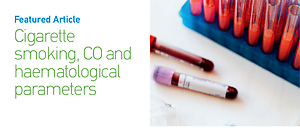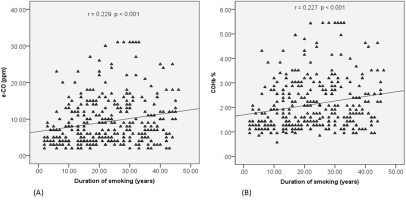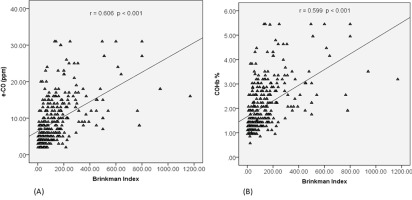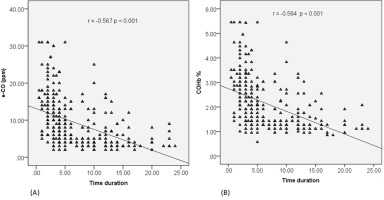INTRODUCTION
Smoking is a leading preventable cause of death and illness worldwide1,2. Smoking has a detrimental effect on the smoker’s life expectancy and has a major economic impact on the family3,4. Annual mortality totals 8 million people, with 7 million of these fatalities directly attributable to tobacco usage5,6. Over 80% of the 1.3 billion tobacco smokers worldwide live in low- and middle-income countries7,8 and tobacco smoking is a critical health issue in Sri Lanka, claiming over 20000 lives each year9. According to WHO statistics, 29.4% of Sri Lankan males are smoking tobacco10,11, and amongst them 19.5% smoke daily12. Smoking is a well-established risk factor for the development of a range of diseases13,14 including major cardiovascular diseases (CVD)15,16, chronic obstructive pulmonary disease (COPD)17,18, and some cancers19,20. Tobacco smoke contains a variety of chemicals known to be harmful to human health. Free radicals, nicotine, and carbon monoxide (CO) are believed to be the most important for pharmacological actions21.
Smoking increases the level of CO in the blood, which may lead to several cardiovascular diseases (CVD). CO displaces oxygen in the red blood cell to form COHb%22. Measurement of CO in exhaled breath (eCO ppm) and carboxyhemoglobin (COHb%) is a non-invasive, objective measure to assess smoking status and has been successfully used in several studies16,22-24. Studies have reported that smoking increases the level of hematologic parameters such as hemoglobin (HB), red blood cells (RBCs), neutrophils, eosinophils, monocytes, and platelets while smoking cessation was associated with a decrease in these values among smokers13,22,25,26. All blood cells are produced in the bone marrow and they mature in the peripheral blood tissue. These haemopoietic mechanisms can be affected when exposed to the harmful substances in cigarette smoke, and tobacco contains more than four thousand chemicals that may affect haemopoiesis21.
However, the information regarding the effect of smoking on blood COHb% and hematological parameters is scarce21. According to the best of the authors’ knowledge, the relationship of smoking with eCO, COHb%, red cell parameters, and white cell parameters have not been studied in a South Asian population, according to the available literature. Accordingly, the study investigates the duration of smoking and effects of smoking severity on eCO, COHb%, and hematological parameters. Thus, it provides new data for a South Asian population that does not smoke as heavily as the Far-Eastern Asian populations12.
At the moment, Sri Lanka does not have baseline values for the above-measured variables in its smoking population. These baseline values and correlations will be critically important when policymakers develop studies on smoking cessation. On the other hand, Sri Lanka has the second-lowest prevalence of daily smoking in South Asia, trailing only India12. Bangladesh, Maldives, Myanmar, Nepal, and Thailand, all have a greater smoking prevalence than Sri Lanka12. Personal cigarette usage in Sri Lanka is also lower than in other Asian countries27. As a result, additional research into the physiological response to this low intensity of tobacco smoking is needed. We also wanted to check existing values with South Asian populations where studies are scarce. Thus, the current study is one of the first studies conducted in Sri Lanka to investigate the above parameters with an objective measure of the severity of smoking using eCO levels27.
METHODS
Study design and setting
A descriptive cross-sectional study was conducted in selected peri-urban MOH (Medical officer of Health area) divisions named Piliyandala, Homagama, Boralesgamuwa, and Ratmalana, in the Colombo district of Sri Lanka.
Participants and sample size
A descriptive study was conducted on adult male daily tobacco smokers (n=360) aged 21–60 years with a smoking history of at least five years. They were randomly selected from peri-urban areas of Colombo district, Sri Lanka. A comparison group of 180 non-smokers was randomly chosen from the same location and matched for age, height, and weight. Non-smokers were defined as respondents who stated at the time of enrolment that they had never smoked or had not smoked in the previous five years, as well as had not smoked more than 100 cigarettes in their lifetime28,29.
Female smoking frequency is very low in Sri Lanka. It is about 0.2%12 as smoking among females is considered a cultural taboo in Sri Lanka. Due to the fact that female smoking prevalence is so low in comparison to male smoking prevalence, we excluded female smokers and thus studied only male subjects to represent the smoking community. Thus, this study was conducted on male smokers.
Smokers and non-smokers with a history of myocardial infarction within the previous 4 weeks, diagnosis of alcohol dependence in the previous six months, or drinking six or more drinks on six or more days a week were excluded. Smokers with psychiatric disorders were also excluded, as smoking prevalence is known to be higher in those with psychiatric illnesses than in the general population30,31.
All participants providing informed written consent and fulfilling the recruitment criteria were included. Confidentiality of all information and identities of participants were strictly maintained and were not disclosed. The sample was randomly selected from the electoral registers of each Grama Niladhari (GN) Office. The electoral register for the year 2016 was used for this purpose.
Data collection
An interviewer-administered questionnaire was used to obtain information on participants’ baseline data, such as occupation, age, number of years of smoking, frequency, and type of tobacco smoking. Information sheets and consent forms were translated to the local languages of Sinhala and Tamil to ensure that it was accessible, easily understood, and available to all members. The participation was voluntary and the subject had the right to withdraw from participation at any time. The anthropometric measurements of height and weight were obtained using standardized measurement techniques using a stadiometer (KT-GFO6A-Kindcare- China) and a portable electronic bathroom scale (Omron HN-283-Japan). All equipment used were calibrated daily and periodically assessed for accuracy.
COHb% and eCO levels were measured using a calibrated portable Bedfont Micro+™ Smokerlyzer® (Bedfont Scientific, UK). The measuring concentration range of the device is 0–500 ppm (parts per million). Measurement of eCO was performed after a minimum time interval of 30 minutes after the last cigarette, as recommended by the manufacturer. Participants were asked to exhale completely, inhale completely, hold for 15 seconds, and then exhale with a disposable mouthpiece. The Smokerlyser (Bedfont®) measures exhaled breath carbon monoxide level (eCO) based on the conversion of CO to carbon dioxide (CO2) over a catalytically active electrode. COHb% levels were automatically calculated based on eCO levels by the device. The smoking severity was estimated based on the Brinkman index, which is calculated by multiplying the duration of smoking (in years) by the number of cigarettes smoked per day32-34.
An aseptically collected sample of venous blood was analyzed to determine the full blood count (FBC) on randomly selected 180 smokers and 180 non-smokers. The 180 smokers were systematically selected based on the smoking severity: mild smokers (n=60) <2 cigarettes/day, moderate smokers (n=60) >2 and <10 cigarettes/day, and severe smokers (n=60) >10 cigarettes/day, based on the available literature35,36. Assessment of full blood count was done by an automated Coulter blood cell counter (Beckmann Coulter Inc. US). Participants identified with abnormal test results were referred to the university medical clinic for further management. The consent form, datasheet, and other data were securely stored.
Statistical analysis
Statistical analysis was performed with SPSS version 23.0 (SPSS Inc.). The normal distribution and the similarity of the variances were tested with the Kolmogorov-Smirnov test before statistical analysis. Groups were compared by Student’s t-test for normally distributed data and Mann-Whitney U test for skewed distributions. The correlations between the normally distributed parameters were analyzed using the Pearson correlation coefficient and Spearman’s rank-order correlation test was used for skewed data. Data are expressed as means with standard deviation (SD) and medians with interquartile range. The level of significance was set at p<0.05.
RESULTS
Baseline characteristics of smokers and non-smokers
There was no statistically significant difference between age and anthropometric measurements of height, weight, and BMI (kg/m2) between smokers and non-smokers (p>0.05). Smokers’ mean (±SD) value of daily cigarette consumption was 5.73±4.88 sticks/day, smoking duration was 22±12.63 years, and smoking-initiation age was 18.7±4.47 years. The median (±IQR) value of the Brinkman index was 80.0±132.0 (Table 1).
Table 1
Baseline characteristics of smokers and non-smokers
COHb% and eCO levels of smokers and non-smokers
Statistically significant high levels of eCO (ppm) (p<0.001) and COHb% were observed among smokers compared to non-smokers (p<0.001) (Table 2). This indicates that the CO arising from the smoke was efficiently bound to the hemoglobin in red blood cells.
Table 2
COHb% and eCO levels of smokers and non-smokers
| Variable | Smokers (n=360) | Non-smokers (n=180) | p* | ||
|---|---|---|---|---|---|
| Median | IQR | Median | IQR | ||
| Exhaled carbon monoxide (eCO ppm) | 7.00 | 8.00 | 3.00 | 1.00 | <0.001 |
| Carboxyhaemoglobin% (COHb%) | 1.75 | 1.28 | 0.95 | 0.16 | <0.001 |
Comparison of hematological parameters between smokers and non-smokers
The smokers had significantly higher Hb, HCT, MCV, MCH, and MCHC, WBC counts, lymphocyte count, monocytes count, and granulocytes count, compared to the non-smokers (Table 3). This would be mostly stimulated by the hypoxia caused by the CO bound Hb being unable to transport O2 to tissues efficiently, thus a rise in erythropoietin would result in the increase in hematological parameters.
Table 3
Comparison of hematological parameters between smokers and non-smokers
| Hematological parameters | Smokers (n=360) | Non-smokers (n=180) | p | ||
|---|---|---|---|---|---|
| Median | IQR | Median | IQR | ||
| RBC (×1012/L) | 5.22 | 0.77 | 5.32 | 0.94 | 0.160 |
| HGB (g/dL) | 14.70 | 2.00 | 14.10 | 2.53 | <0.001** |
| HCT% | 45.50 | 7.20 | 44.50 | 7.50 | 0.004* |
| MCV (fL) | 87.00 | 6.30 | 84.20 | 7.55 | <0.001** |
| MCH (pg) | 28.40 | 1.80 | 27.40 | 2.75 | <0.001** |
| MCHC (g/dL) | 32.50 | 1.80 | 32.00 | 2.10 | 0.001* |
| WBC (×109/L) | 7.70 | 2.00 | 7.00 | 1.70 | <0.001** |
| PLT (×109/L) | 239.00 | 59.00 | 250.00 | 76.25 | 0.205 |
| Lymphocytes (×109/L) | 2.90 | 1.00 | 2.60 | 0.83 | 0.023* |
| Monocytes (×109/L) | 0.60 | 0.20 | 0.50 | 0.20 | <0.001** |
| Granulocytes (×109/L) | 3.90 | 1.50 | 3.60 | 1.70 | <0.001** |
Correlation of smoking variables with eCO and COHb% levels
There was a strong, positive correlation between the number of cigarettes smoked per day with eCO and the COHb% levels (p<0.001) (Figure 1). The duration of smoking (p<0.001) (Figure 2) and Brinkman index (p<0.001) (Figure 3) were also strongly positively correlated with eCO and the COHb% levels (p<0.001). There was a strong negative correlation between the time gap from the last smoked episode with eCO and COHb% levels (p<0.001) (Figure 4).
Figure 1
Correlation between the number of cigarettes smoked per day with (A) eCO levels, and (B) COHb% levels of smokers
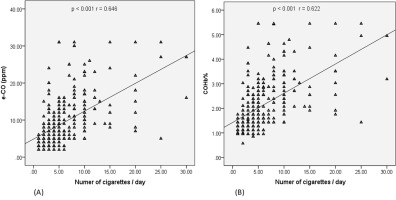
Correlation between the number of cigarettes smoked per day and hematological parameters
A Spearman’s rank-order correlation test was used to establish the relationship between smoking-related variables and hematological parameters. There was a significant, positive correlation between the number of cigarettes smoked per day and the MCV (r=0.148, p=0.046), and the MCH (r=0.184, p=0.013).
Correlation of Brinkman index and hematological parameters
A Spearman’s rank-order correlation test was used to determine the relationship between the Brinkman index and hematological parameters. There was a significant positive correlation with Brinkman index and MCV (r=0.227, p=0.002), MCH (r=0.270, p≤0.001), and total granulocyte count (r=0.153, p=0.043).
DISCUSSION
This study was conducted to assess the effects of tobacco smoking on exhaled breath carbon monoxide (eCO), blood carboxyhemoglobin levels (COHb%), and hematological parameters, amongst Sri Lankan adult male tobacco smokers. Sri Lanka currently lacks baseline values for the aforementioned characteristics in its smoking population. These baseline values and associations will be important in the development of smoking cessation studies; a more indepth study into the physiological response to low-intensity tobacco smoking is needed.
Smokers’ values were compared with weight, height, BMI and age-matched non-smokers (p>0.05) to improve the scientific validity of the study. eCO has been used in many studies14,16,22-24,37,38 to assess the smoking status of tobacco smokers. Combusted cigarettes produce CO which enters the bloodstream by diffusion at the pulmonary capillaries. CO has a high affinity to hemoglobin and binds to hemoglobin in red blood cells and was measured as COHb% in the present study. According to the literature, 85% of CO in the body is attached to hemoglobin in circulating red blood cells, and the majority of the remaining CO is linked with myoglobin in the muscles39. The eCO is in dynamic equilibrium with COHb%. The present study is the first study conducted in Sri Lanka to determine the severity of smoking taking the eCO and COHb% into consideration. CO levels in breath can be influenced by many factors such as diet, exercise, inflammation, and time of the day23. It is believed that CO is produced endogenously, mainly through oxidative stress and inflammation of lung diseases such as COPD and asthma. However, a study has observed that there is no significant difference in CO values of smokers with normal lung function compared to smokers with COPD23.
In this study, there was a statistically significant higher eCO concentration and COHb% of smokers than non-smokers. The results of the study are in line with other studies16,24,37. Further, the present study showed a strong positive correlation between eCO and COHb% with the number of cigarettes smoked per day, duration of smoking22,24,37 and Brinkman index. Besides, there was a strong negative correlation between eCO levels as well as COHb% with the time from the last cigarette. Therefore, the measurement of smoking through the assessment of eCO can be objectively used to assess the smoking status. In a primary care setup, it is very important to identify current smokers, in order to deliver quitting advice and to promote quitting and adherence to quitting amongst smokers. Further, as the method of testing is easy to conduct, eCO measurement further promotes better monitoring of patients who have still not quit smoking.
Measurement of eCO is more practical and easier to sustain in low-cost healthcare delivery settings such as in Sri Lanka. It is practically difficult in primary care to determine cotinine levels in the blood and other samples as it is not cost-effective40. Further, the cotinine levels are known to vary depending on the ethnic group. A portable exhaled breath CO monitor is a cost-effective calibrated device which is easy to administer in a clinic setting. Further, the results are immediately available to the healthcare provider as well as to the patient, so that eCO level can be easily determined. Therefore, a portable CO monitor is a highly reliable tool to assess smoking severity. Once current smokers are identified with the eCO monitor, it will help to deliver more effective counseling sessions for them24,41, as both the counselor and smoker can have an excellent quick assessment of smoking status or the success of quitting attempts.
Robust scientific evidence exists to support the relationship between smoking and cardiovascular illness42,43. The exact mechanisms of the onset of disorders due to smoking cigarettes are unknown, but these effects are thought to be caused by changes in blood physiology, infections and inflammation, oxidative stress and antithrombotic effects, and changes in the fibrinolysis system13. Smoking causes alterations in various hematological parameters13,41. The present study confirmed that smokers had significantly higher levels of total white blood cell (WBC) counts, lymphocyte counts, monocyte counts, and granulocyte count, compared to non-smoker controls. Increasing WBC counts is a simple marker for endothelial injury43. Similar to our study, Acik et al.21 found higher WBC, neutrophil, eosinophil, monocyte, and lymphocyte counts, compared to non-smokers.
Exposure to the irritant chemicals of tobacco smoke causes inflammation of the bronchial mucosa which increases the WBC counts. Further, an increase in WBC count has been described as a risk factor for subclinical atherosclerosis as well as vascular wall thickening43. Similar leukocytosis has been observed in other studies25,26. Although the exact mechanism of leukocytosis is not fully clarified, and smoking-induced leukocytosis may be due to several factors, and it may be explained in different ways. Leukocytosis may be the result of the nicotine-induced release of catecholamine and steroid hormones from the adrenal gland. It is known that an increase in the level of certain endogenic hormones, such as epinephrine and cortisol, increases the number of circulating leukocytes27,28.
WBC, platelet and red blood cell production in bone marrow increases due to stimulation by erythropoietin as a response to CO-mediated hypoxia21. This, in turn, leads to increased hemoglobin levels. According to the present study, we assessed all subgroups of leukocytes, which were also significantly higher in smokers than non-smokers. Furthermore, the average cigarette consumption of our selected population is not high though they had this significantly higher leukocyte level compared to the non-smokers. This is significant evidence to confirm that there is no safe level of smoking for an individual’s health.
According to the findings, smokers had significantly higher levels of hemoglobin (Hb) values and this may be due to the CO-mediated stimulation of hypoxia inducing greater production of hemoglobin. Carbon monoxide binds to Hb and forms carboxyhemoglobin, an inactive form of hemoglobin that cannot carry oxygen. Carboxyhemoglobin also alters the Hb degradation curve on the left side, resulting in a decreased ability of Hb to deliver oxygen to tissue. To compensate for the reduced oxygen supply, smokers maintain higher hemoglobin levels than non-smokers13,21. The synthesis of erythropoietin in renal capillary tubular cells increases in response to hypoxia. These significant elevations in hemoglobin level are in accordance with previous studies13,21. This is known to account for the higher levels of hemoglobin of smokers of the present study.
The present study established significantly larger values of MCV, MCH, and MCHC, amongst smokers compared to non-smokers. Similar increases in the red cell indices have been observed with significantly larger values of MCV and MCH among smokers, while differences in values of MCHC were not significant between smokers and non-smokers13. MCV, MCH, and MCHC, are the three main red blood cell indices that help in measuring the average size of red cells and the hemoglobin structure of the red blood cells. MCH is the average weight of hemoglobin that is present inside a single red blood cell whereas MCHC denotes the amount of hemoglobin in a specific volume of ‘packed’ red corpuscles or cells. Further, a significant, positive correlation between Brinkman index and MCV, MCH, and granulocytes count, was also identified. Thus, this study established a relationship between the Brinkman index and hematological parameters. In addition to that, there was a significant positive correlation between the number of cigarettes smoked per day and MCV and MCH.
This study supports the idea that prolong cigarette smoking has adverse effects on the hematologic parameters28. Prolonged smoking exposure seems to have contributed to inducing the above changes of hemoglobin within the red cells. There was no significant difference in RBC count and that finding is compatible with the study conducted by Malenica13. However, a study conducted by Sherke et al.43 found that the RBC count too increased with smoking among adult males. The present study did not find any difference between smokers and non-smokers in terms of platelet count. This finding is consistent with other studies43.
Strengths and limitations
Our research has many strengths. We used a random sampling methodology to choose the sample. The sample size was large, with 540 participants. The fact that we selected age and anthropometric parameters matched non-smokers to match with smokers was our greatest strength. All measurements were taken with calibrated standard equipment. Furthermore, this is the first study ever conducted in Sri Lanka amongst smokers to estimate the effects of tobacco smoking on exhaled breath carbon monoxide (eCO) levels, blood carboxyhemoglobin levels (COHb%), and hematological parameters, amongst adult male tobacco smokers. Our research has several limitations. We did not do a subgroup analysis because this is cross-sectional research. However, we selected them in a standard manner. Furthermore, their smoking history was approximated based on their verbal response.
CONCLUSIONS
Cigarette smoking is associated with a significant increase of exhaled breath CO as well as COHb% level and it is positively correlated with the number of cigarettes smoked per day and the Brinkman index. Measurement of eCO using a CO monitor is a quick, non-invasive, cost-effective easy and efficient test to confirm the patient’s smoking status. Continued cigarette smoking is associated with alterations of peripheral red cell counts, red cell indices, and white cell counts. These alterations might be associated with a greater risk for developing cardiovascular diseases subsequent to long-term smoking. The present study was rigorously conducted to confirm some of the known effects of cigarette smoking hitherto not estimated in the Sri Lankan population. The purchase of the monitor although expensive to initially purchase is relatively maintenance-free and does not involve costly calibration methods. These simple methods can be used effectively to deliver better healthcare and facilitate the quit smoking efforts of Sri Lankan smokers.

